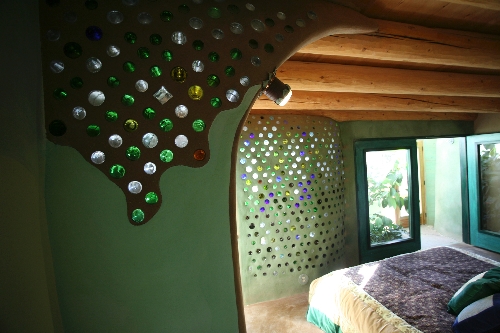Earthships at home in their environment
I tend to take a pragmatic approach to life. I suppose that's why I'm so enamored with the idea of green living. It is a sensible practice that addresses most of the primary issues of our time. Everything from health, comfort, economics, environment and happiness can be optimized using an integrative approach that adds balance and perspective to our life experience.
The concept of integrative design is powerful, whether applied to one's life choices or to the built environment, since it often mimics natural processes that leave no options off the table and allows ideas to flourish outside of normally accepted standards. One of the best examples of using integrative design lies in the Earthship, a concept of architect Michael Reynolds, who has spent 35 years researching and developing self-sufficient housing made from recycled materials.
An Earthship is a home that is both Earth-friendly and people-friendly, while requiring little or no mortgage payment or utility bills. The integrative approach effectively addresses many of the major problems of our time, including energy, water, waste and pollution. Many of the topics I've written about in this column have been standard components of Earthship design for years, including passive solar orientation, thermal mass, renewable energy and gray water systems. All are important, but in an Earthship they are deeply integrated and codependent.
Earthships have been built around the world and, depending on the climate, can be completely independent of all utility services while still maintaining the benefits and convenience of a modern home. That does not mean that each family must be an island unto itself. In fact, the Earthship concept is all about vibrant, interactive community. It does mean that we should take a serious look at our "business-as-usual" urban and suburban development, since much of what we are doing is creating unnecessary harm.
We are not winning the sustainability race.
In Southern Nevada, we are primarily challenged by water, yet we waste an inordinate amount of it. An Earthship can harvest, store and safely process enough water for its inhabitants in a climate with as little as 7 inches of annual rainfall. Although we are well below that average, adopting deeper concepts of water conservation and reuse could greatly reduce our excessive water consumption. The key is in the cycle of beneficial reuse.
Adopting other water-harvesting principles such as those found in Brad Lancaster's "Rainwater Harvesting for Dry Lands and Beyond" could almost provide us with all the water we need, reducing the demand on the Colorado River and our water delivery infrastructure.
We have a hot climate with lots of solar energy. Rather than fight off the heat of summer with massive, energy-sucking air conditioners (I know plenty of people who suffer from that affliction in the form of huge energy bills), an Earthship is designed to make the most of local conditions. Passive orientation costs nothing, yet reduces heat gain in summer and maximizes it in winter.
Massive walls and berms minimize interior temperature swings and make it easy to maintain comfort. South-facing windows provide energy for plants that clear the air, filter gray water and can provide food year-round.
Perhaps best of all, an Earthship is constructed of mostly local materials, some natural and some recycled. This greatly reduces the need to ravage forest habitat and ship lumber over long distances. Beneficial reuse of existing materials reduces "waste" while adding incredible strength and durability, resulting in structures that can withstand natural disasters and last for centuries. These are all incredibly green practices.
I hope Mr. Reynolds won't mind if I paraphrase his beautiful mission statement: To evolve existing methods of living, home by home, slowing down and ultimately reversing the negative impact of human development as it relates to the Earth's ability to continue to support life, by empowering people to make positive changes in their own lives.
I urge you to visit www.earthship.com to learn more. Earthship Biotecture offers plans, assistance, workshops and even has listings of Earthships for sale or rent. My wife and I once stayed in an Earthship near Taos, N.M. It was a wonderful and pragmatic experience in green living.
Steve Rypka is a green living consultant and president of GreenDream Enterprises, a company committed to helping people live lighter on the planet. For more information and links to additional resources relating to this column, or to reach Steve, please visit www.greendream.biz.



















